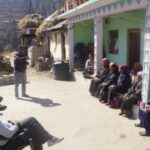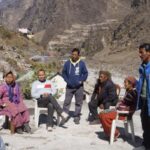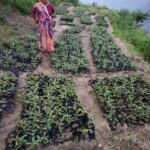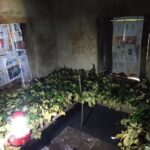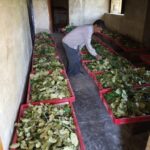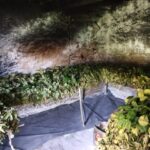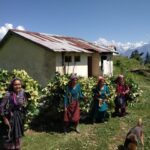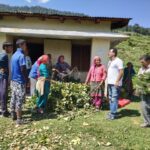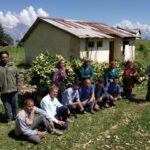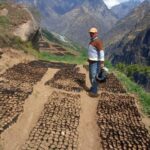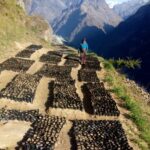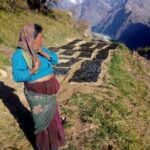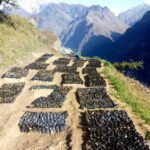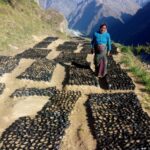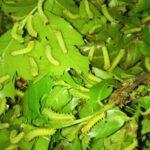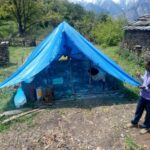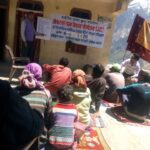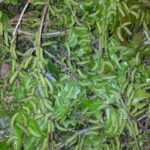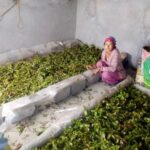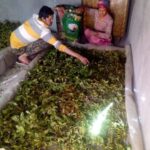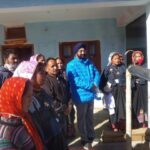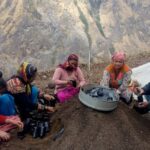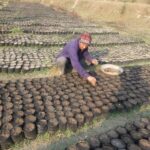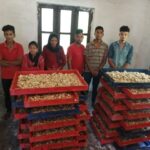UTTARAKHAND OAK TASAR DEVELOPMENT PROJECT
IMPLEMENTATION OF UTTARAKHAND OAK TASAR DEVELOPMENT PROJECT IN DISTRICT CHAMOLI OF UTTARAKHAND UNDER CENTRAL SECTOR SCHEME COMPONENT OF TRIBAL SUB PLAN (TSP)
INTRODUCTION AND BACKGROUND OF THE PROJECT
The picturesque state of Uttarakhand in India boasts a climate that is not only environmentally rich but also conducive to the cultivation of a diverse range of silkworm species. Among these are the revered Mulberry, the indigenous Oak Tasar, the exotic Muga, and the versatile Eri varieties. Flourishing predominantly within the serene landscapes of the Garhwal and Kumaun hills, the Oak Tasar silkworms have found their niche by sustaining themselves through the consumption of the foliage from trees that include the stately Quercus serrata, the resilient Q. incana, the Himalayan Q. himalayana, and the enigmatic Q. semicarpifolia. These host plants, intrinsic to the verdant expanse of Uttarakhand’s natural forests, extend across an impressive terrain of approximately 20,000 hectares. It is within this breath taking realm that the potential for economic upliftment of economically marginalized families residing in the hilly regions is not just a possibility but a promising reality. The concerted efforts of esteemed institutions such as the Department of Sericulture, Government of Uttarakhand, and RTRS, CSB, Bhimtal, are directed towards catalyzing the proliferation of Oak Tasar culture. By providing robust technological and extension support, these organizations play an integral role in empowering the farming communities engaged in this transformative endeavour. With their unwavering commitment, they create an enabling environment that extends beyond mere cultivation to nurturing a sustainable and holistic sericulture ecosystem.
Under the vigilant gaze of the Ministry of Textiles, the Central Silk Board takes on the mantle of project approval and meticulous oversight. The project’s evaluation encompasses a rigorous process guided by the well-defined parameters of ISDSI/CSS/MGNREGS schemes. This multifaceted evaluation framework is grounded in both meticulousness and comprehensiveness. It encompasses a gamut of activities, including diligent on-site inspections conducted by seasoned officers from the Ministry of Textiles/DOS/CSB or other authorities designated by the Ministry. Additionally, the evaluation process incorporates a range of techniques such as impact assessments, social audits, and third-party monitoring, all of which are orchestrated by independent bodies. These collective efforts create a robust evaluation process that ensures transparency, accountability, and real-time adaptability. As the project unfurls, the oversight baton is handed to the Project Implementation and Monitoring Committee (PIMC). Helmed by the Principal Secretary/Secretary of the Department of Sericulture, Government of Uttarakhand, this committee is emblematic of dynamic collaboration and effective governance. Charged with the onus of continuous project oversight, the PIMC plays a dual role: ensuring the alignment of project progress with established objectives and providing a platform for deliberative decision-making. Through consistent monitoring, assessment, and recalibration, the PIMC becomes a conduit for translating the project’s vision into tangible outcomes, thereby solidifying the commitment towards sustainable sericulture and community well-being.
AIMS AND OBJECTIVES OF THE PROJECT
1. Chart a comprehensive strategy to bolster the oak tasar sector, with a dedicated timeline spanning 3-4 years, strategically addressing pivotal concerns associated with seed production while concurrently optimizing the silk value chain for oak tasar.
2. Engineer the establishment of indispensable infrastructure and seamless linkages to create a stable foundation for oak tasar silkworm seed cultivation. The overarching objective is to achieve self-sufficiency in the production of both fundamental and commercially significant seed varieties.
3. Set in motion the creation of a robust production base, meticulously designed to catalyze employment opportunities, particularly advantageous for local communities inhabiting hilly terrains.
4. Drive forward sustainable regional progress through the dissemination of cutting-edge technologies, fostering responsible utilization of precious natural oak forest resources, and cultivating diverse income streams for residents residing in elevated areas.
5. Anchor the triumphant trajectory of the oak tasar sector through a resolute commitment to proficiently manage the entire silk value chain. This comprehensive approach spans multiple dimensions, ranging from meticulous production and processing to astute marketing strategies.
COMPONENTS AND ACTIVITIES OF THE PROJECT
1. Initiate the establishment of new block plantations featuring Quercus serrata with the valuable support of MGNREGA assistance. These efforts are strategically targeted at low and middle altitudes, thereby contributing to the stabilization of seed crops.
2. Facilitate the provisioning of essential backing for cold storage facilities, dedicated to preserving seed cocoons within low-altitude regions. Furthermore, devise and develop infrastructure for seed cocoon preservation at well-suited high-altitude locales to facilitate basic seed production.
3. Introduce the innovative Seed Zone concept, meticulously designed to amplify the efficiency of seed production endeavours.
4. Pave the way for the creation of dedicated chawki rearing centers, primed to facilitate rearing activities up to the second stage under controlled indoor conditions. These facilities will be extended to lend crucial support to the essential task of basic seed rearing undertaken by adopted seed farmers.
5. Extend indispensable assistance to private graineurs, a key cornerstone in driving forward commercial seed production efforts.
6. Implement a comprehensive door-to-door disinfectant service coupled with mobile disease testing mechanisms, specifically geared towards minimizing disease-related losses.
7. Provide specialized rearing appliances and robust disinfectant support to empower commercial farmers in their ventures.
8. Elevate the value chain’s potency through the seamless integration of reeling and spinning activities, ultimately contributing to the efficient production of yarn.
9. Execute impactful capacity-building initiatives aimed at empowering project personnel and stakeholders alike. These initiatives take the form of comprehensive training sessions and enlightening exposure visits.
10. Offer unwavering support to the crucial aspects of publicity and technology transfer through a multifaceted approach encompassing awareness programs, participation in krishi melas (agricultural fairs), as well as the organization of seminars and workshops, thereby fostering a well-rounded dissemination of knowledge and innovation.
TARGET AREA OF THE PROJECT
The oak tasar project was executed in the high-altitude tribal areas of the Joshimath block, chosen for its suitability for silk worm rearing on oak plants. This location is situated in the Chamoli district of Uttarakhand.
TARGET GROUPS AND BENEFICIARIES OF THE PROJECT
The project’s primary target group is composed of Scheduled Tribe (ST) families within the designated project area.
FUNDING PARTNER OF THE PROJECT
The Central Silk Board (CSB), Ministry of Textiles, Government of India, Bangalore has provided funding for the project through the Directorate of Sericulture (DOS), Department of Sericulture, Government of Uttarakhand, Dehradun.
SANCTIONED BUDGET OF THE PROJECT
The project was approved by the Directorate of Sericulture in 2018, under the sanction order No. 1605/DOSUK/Tech Branch/NGO Selection/ 2017-18, dated 20.01.2018. The total budget for the project, sanctioned by the Directorate of Sericulture for a duration of four years, was Rs. 3,46,36,500.00.
OUTCOMES AND ACHIEVEMENTS OF THE PROJECT
The successful implementation of the Uttarakhand Oak Tasar Development Project has led to the establishment of several outcomes and achievements.
1. Stable infrastructure and linkages have been created to stabilize Oak Tasar silkworm seed crops, with the ultimate goal of achieving self-sufficiency in the production of basic and commercial seed.
2. A production base has been created, which generates employment opportunities and promotes sustainable development in the region by disseminating technology and exploiting natural resources related to the oak flora and fauna.
3. Effective management of the Oak Tasar silk value chain has been ensured through the implementation of measures to ensure sustainable and profitable production, processing, and marketing of Oak Tasar silk products.
4. The project has strengthened the Oak Tasar sector in the project area by addressing critical issues related to seed production, infrastructure, and value chain management, while promoting sustainable development and creating employment opportunities for the local population.
5. Capacity building of project personnel and stakeholders has been achieved through training and exposure visits, and support for publicity, technology transfer, and awareness programs such as krishi melas, seminars, and workshops have been provided.
6. New block plantations of Quercus serrata have been raised and maintained with support under the Mahatma Gandhi National Rural Employment Guarantee Act (MGNREGA) to stabilize seed crops.
7. Support for cold storage facilities for the preservation of seed cocoons at low altitudes and infrastructure for seed cocoon preservation has been developed at high altitudes at suitable locations to support basic seed production.
8. Chawki rearing centers have been established to promote the concept of rearing up to the second stage under indoor conditions, and these facilities will be extended to support basic seed rearing by adopted seed farmers.
9. Assistance has been provided to private graineurs for the production of commercial seed, and door-to-door disinfectant service agents and mobile disease testing have been implemented to minimize disease losses.
10. Commercial farmers have received support for rearing appliances and disinfectants, and value chain addition has been integrated by supporting reeling/spinning activities for yarn production.


